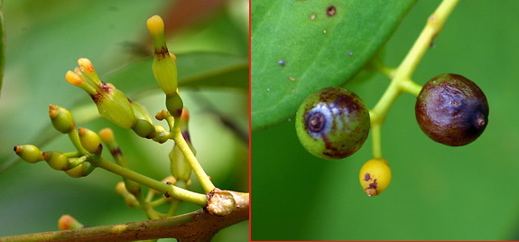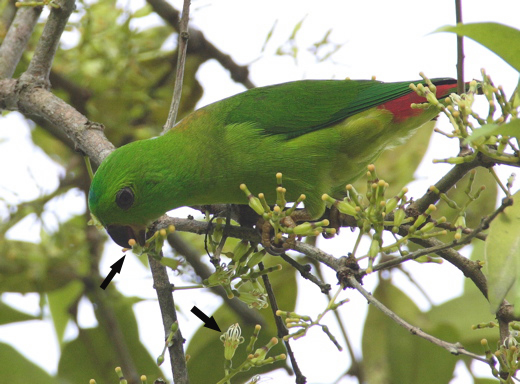The mistletoe Macrosolen cochinchinensis has flowers that only open when visited by birds. When a bird grasps the flower bud, the petals suddenly unfold to expose the stamens and style. At the same time pollen is probably discharged from the anthers on to the bird. The bird helps itself to the nectar and at the same time assists in the pollination of the flower.
The image above (left) shows the elongated flower buds and the yellowish aborted ovaries that failed to be pollinated. One of the flowers was subjected to a slight squeeze (by me, not the parrot) on its swollen portion, resulting in the petals beginning to unfold to expose the stamens and style. The image on the right (above) shows two fruits and an aborted ovary.
Most of these mistletoes in my garden fail to form fruits, possibly because pollinating agents, mainly nectar-seeking birds, are absent.
In early September 2007, I managed to see images by Chan Yoke Meng showing a female Blue-crowned Hanging Parrot (Loriculus galgulus) foraging amongst such a mistletoe plant. One of the images clearly shows the parrot with its bill clamped on to the swollen flower bud (above, top arrow). This of course will trigger the flower bud to open. The flower below the parrot (lower arrow) most probably opened as a result of such a treatment.
The images below show the acrobatic abilities of this hanging parrot, being able to harvest nectar the right way up as well as upside down. The enlarged image (bottom left) clearly shows the parrot’s tongue (arrow) as it takes in the nectar from the flower. The other enlarged image (bottom right) again shows the parrot’s bill at work on the flower bud.
Obviously this parrot is one of this mistletoe’s pollinators. Sunbirds also visit these flowers, but whether they act similarly as this parrot, I have to wait for a photographer to provide the evidence.
According to Forshaw (1977), these hanging parrots feed on nectar, fruits, seeds, blossoms and possibly small insects. Wells (1999) states that they visit the flowers of coral trees (Erythrina spp.), “apparently for nectar but this has not been proven in the field.”
Earlier postings on mistletoes can be viewed here: 1, 2, 3, 4 and 5.
YC Wee
Singapore
September 2007
(Images: top two by YC Wee; Others by Chan Yoke Meng)
References:
1. Forshaw, J. M. (1973). Parrots of the world. N.J.: T.F.H. Publications, Inc.
2. Ladley, J.J., Kelly, D. & Robertson, A.W. (1997). Explosive flowering, nectar production, breeding systems, and pollinators of New Zealand mistletoes (Loranthaceae). New Zealand J. Bot. 35:345-60.
3. Wells, D.R. (1999). The birds of the Thai-Malay Peninsular. Vol. I, Non-passerines. Academic Press, London.












2 Responses